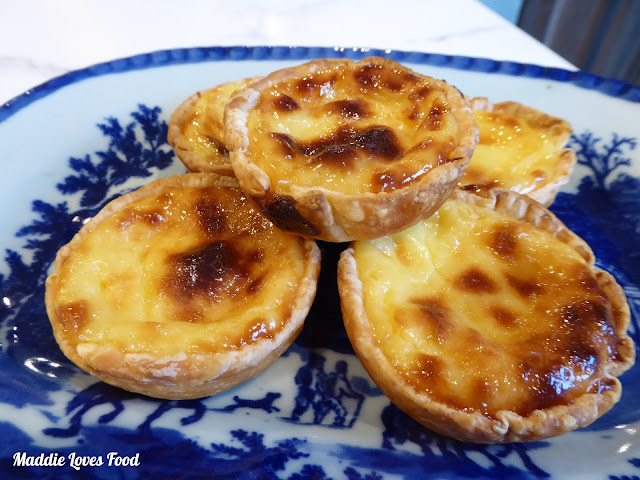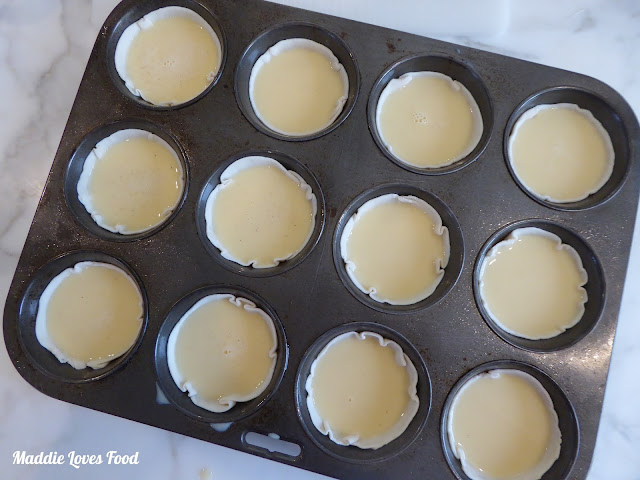An easy recipe for Portuguese Custard Tarts
Monday, March 28, 2016
There is nothing quite like the scorched top of
a freshly baked Portuguese Tart. The contrast of the irregular, blackened spots which stand out
against the golden, gleaming baked custard is so alluring, as is the shattering
crunch that sounds upon biting into the crispy, multi-layered pastry.
I remember many times in my childhood when my family would take a detour to Petersham to pick up a tray-full of those legendary custard tarts. Although the plain custard tart is a sweet pastry common to many
global cuisines (think the crumbly, short, pale yellow Dan Tart at Asian bakeries or the classic, gently baked
English custard tart), Pasteis de Nata
are iconic products of Portuguese cuisine.
What makes these tarts so distinguishable from their counterparts is the method is that caramelised top, which comes from the way in which they're cooked. The custard filling is baked at a hot temperature, causing the sugars in it to catch under the high heat and create that magical pattern on top.
These tarts may not be exactly like those you can buy from a
traditional Portuguese pastry shop, but they come pretty close. Using
store-bought puff pastry, they’re easy to make and are a delightful, home-cooked version that replicates the same crunchy tart base and creamy, sweet custard
that draws fans from around the globe.
The custard for the filling is made in the conventional way, by heating a mixture of sugar, egg yolks, cornflour, cream and water in a saucepan along with a strip of lemon rind until it melds to a thick, fragrant custard.
I used to have a lot of trouble making custard, with the most difficult part being gauging when it was ready. In the past it’s been
overcooked to the point that it splits and forms an unattractive conglomerate of yellow curds; other times it's been under-cooked and has tasted too
strongly of cornflour. I’ve found that it’s okay to under-cook the custard for these tarts a
little (as long as it tastes like the cornflour has been cooked out) because it
continues to cook and set in the oven.
For the base, a sheet of puff pastry is rolled into a
cylinder which is cut into 12 equal rounds, each in turn rolled out to line the bottom
and sides of greased muffin tins. This technique imitates the layers and layers of flaky
pastry found in the traditional tarts, with the pastry baking to a golden crunch in the oven.
The cooled custard is then into the prepared tins and popped onto the top shelf of the oven. Watch as the tops bubble and blister as they
bake.
Recipe for Portuguese
Custard Tarts
Adapted from this recipe
Ingredients
- 3 egg yolks
- ½ cup caster sugar
- 2 tablespoons cornflour
- ¾ cup single cream
- ½ cup water
- 2cm strip of lemon rind
- 1 teaspoon vanilla extract
- 1 sheet ready rolled puff pastry
Method
1. Preheat the oven to 220oC fan-forced. Grease a 12
hole muffin pan and take the pastry out to thaw.
2. In a medium-sized saucepan, whisk the egg yolks, sugar and
cornflour until combined, then gradually add the cream and water. Place over
medium heat, add the lemon rind and continue whisking until the custard boils
and thickens (this will take about 15 minutes depending on your stovetop). Once
thickened – it will coat the back of a wooden spoon and leave a line when you
draw your finger through the back of said spoon – discard the lemon rind, cover
the surface with cling wrap and let the custard cool.
3. Cut the thawed pastry sheet in half, then place the two
halves on top of one another. Roll up the pastry tightly from the short end,
then cut the log into twelve equal rounds about 1cm long.
4. Take one round and
use a rolling pin to carefully roll it out on a board or floured surface to a thin, flat circle about 9cm in diameter. Transfer into the greased muffin tin,
using your fingers to ensure it's completely pressed into the crevices. Repeat for the remaining eleven rounds.
5. Divide the cooled custard into the pastry cases using a
spoon or lipped jug, leaving about 5mm at the top. Bake on the top shelf of the
oven or about 20 minutes, then grill for 3-5 minutes or until the tops are well
browned and develop darkened spots. Stand in tins for 5 minutes, then turn out
onto a wire rack to cool.
















4 comments
omg!! portugese tarts, something i never thought to make because I prefer to just buy but it but making my own... not sure if good or dangerous! hehe cause you know, need to eat them all when fresh! :P
ReplyDeleteI love portuguese tarts never tried to make them but might give it a try on the weekend. Hope mine turn out as good as yours!
ReplyDeleteThis comment has been removed by the author.
ReplyDeleteThanks for the lovely comment Stacy! Let me know if you end up testing it out! Apologies about the pinterest issue, we're working on that and hopefully it will be fixed soon :)
Delete